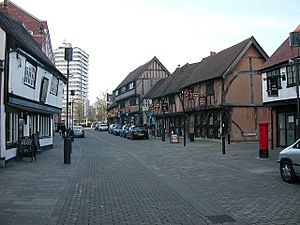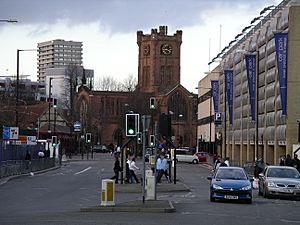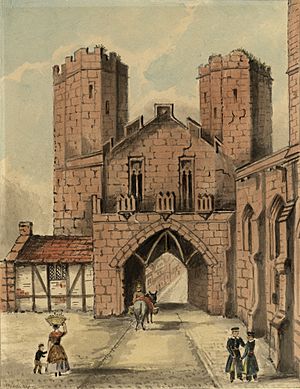Spon Street facts for kids

Modern-day Spon Street, looking west towards Spon End
|
|
| Length | 0.16 mi (0.26 km) |
|---|---|
| Location | Coventry, England |
| Postal code | CV1 |
| Coordinates | 52°24′29″N 1°30′59″W / 52.408016°N 1.516320°W |
Spon Street is a really old and important street in the middle of Coventry, a city in the West Midlands of England. People sometimes call it Historic Spon Street or Medieval Spon Street because of its long past.
It used to be part of a main road connecting Gosford and Birmingham. This old road was used for a long time, even though newer roads were built. But in the 1960s, when Coventry's Inner Ring Road was built to help traffic flow better, Spon Street was cut in two.
Contents
The Street's Path
The street originally started near St John the Baptist Church. It then stretched west out of the city centre, through an area called Spon End, all the way to the bottom of Hearsall Lane.
After the Inner Ring Road was built, only the part of the street from St John's Church to the ring road kept the name Spon Street. The eastern part outside the ring road became a bike path with no name. The section further west is now known as Upper Spon Street.
Spon Street's Long History
The area around Spon End started to grow in the 1100s and 1200s. This is when people who dyed cloth and tanned leather began to gather there. They set up their businesses just outside the city wall, near the Birmingham road and the River Sherbourne.
A strong gate called Spon Gate was built across the road around 1391. Dyers and tanners chose this spot because their work could be quite smelly. Being outside the city walls meant they wouldn't bother the people living in the city centre. They also needed easy access to clean water, which the River Sherbourne provided.
Back then, Spon Street was full of bars and tenements (small apartments). It stretched from where the West Orchards shopping centre is today to the meeting point of Allesley Old Road and Hearsall Lane.
Through the 1300s and 1400s, Spon Street was mostly known for cloth and leather work. Most residents were tanners, dyers, and saddlers (people who make saddles). By the 1800s, things had changed a lot. A survey in 1851 showed that 137 homes on Spon Street were involved in watchmaking.
Spon Gate was said to be the most beautiful gate in the city wall. However, it was taken down in the late 1700s to make it easier to get into the city centre. Even after the gate was gone, Spon Street was still narrow and busy. This led to the building of Lower Holyhead Road in 1828 to help with traffic.
In the 1800s and early 1900s, many buildings on Spon Street became shops, especially closer to the city centre. Spon Street itself was lucky during World War II and didn't suffer much damage. However, the wider Spon End area was hit.
Because of the war damage and the "dull and sad look" of its Victorian houses, the city decided in 1957 to make Spon End a "Comprehensive Development Area." This meant the city could buy properties there, even old medieval ones on Spon Street, to build new housing.
More historic buildings were lost when the Inner Ring Road was built in 1961-62. A survey in 1965 found only 34 timber-framed buildings left in the city. This was a big drop from 100 in 1958, and 240 after the war.
To fix this problem and save the remaining buildings, a plan started in 1967. It aimed to restore shops on Spon Street and move other threatened historic buildings from Much Park Street to Spon Street. The first restoration work happened from 1968 to 1975. The building at 7-10 Much Park Street was moved between 1970 and 1974.
Some people criticized the restoration work at the time. They felt it wasn't careful enough. Many old features were removed because they weren't original. For example, all the chimney stacks were taken down because they were made of Georgian or Victorian bricks. This way of restoring buildings has been debated since the mid-1800s. The Society for the Protection of Ancient Buildings believes it "tries to change an old building by erasing its true history."
Despite these debates, Spon Street became one of Coventry's first Conservation Areas in 1967. Its buildings were given Grade II listed status in 1974, meaning they are protected for their historical importance.
Spon Street Today
Today, Spon Street is promoted as one of Coventry's main tourist attractions. You can find many pubs, cafes, and shops there. These are in either original or moved medieval buildings. Old medieval streets didn't have separate pavements (sidewalks). So, Spon Street has flat kerbs (edges) to make it feel like those old streets.
The Old Windmill Pub
One of the businesses on the street is The Old Windmill. It's Coventry's oldest pub that is still standing! People think it dates back to at least the 1500s. Like other buildings on Spon Street, it became Grade II listed in 1974.
It's a timber framed building, meaning its main structure is made of wood. The first floor sticks out over the ground floor (this is called oversailing). The outside has a stucco finish. Until 1930, the pub brewed its own beer, with a brewing shed in the back yard. A big renovation in 1985 enclosed the yard and opened up the ground floor, making the bar area much bigger.
163-4 Spon Street
The building you see at 163-4 Spon Street wasn't always there. It was originally on Much Park Street, which is to the south-east of the city centre. It was moved as part of Coventry's first "Townscape Scheme," starting in 1970. The move was finished in 1974, and then the building was also given Grade II listed status.
It's described as a three-story timber-framed house. It was first built in the late 1400s or early 1500s. Both the first and second floors stick out over the one below. As of 2020, it houses a HIFI equipment shop.
Spon Street Substation
Between 172 and 180 Spon Street, there's an electrical substation. It's hidden behind a wooden fence that shows historical scenes and figures. The fence also provides interesting information about the street's past.



